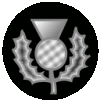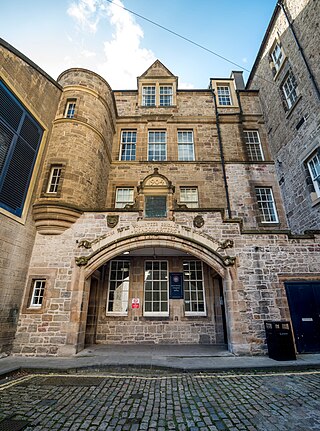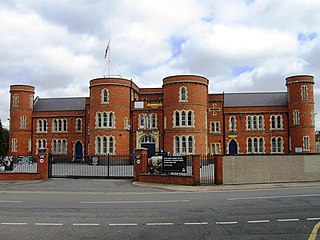
The 9th (Scottish) Division, was an infantry division of the British Army during the First World War, one of the Kitchener's Army divisions raised from volunteers by Lord Kitchener to serve on the Western Front during the First World War.

The 52nd Lowland Volunteers is a battalion in the British Army's Army Reserve or reserve force in the Scottish Lowlands, forming the 6th Battalion of the Royal Regiment of Scotland, also known as 6 SCOTS. Due to its erstwhile association with the 1st Regiment of Foot, it is the senior Reserve line infantry battalion in the British Army. It is one of two Reserve battalions in the Royal Regiment of Scotland, along with 51st Highland, a similar unit located in the Scottish Highlands.

The Cameronians (Scottish Rifles) was a rifle regiment of the British Army, the only regiment of rifles amongst the Scottish regiments of infantry. It was formed in 1881 under the Childers Reforms by the amalgamation of the 26th Cameronian Regiment and the 90th Perthshire Light Infantry. In 1968, when reductions were required, the regiment chose to be disbanded rather than amalgamated with another regiment, one of only two infantry regiments in the British Army to do so, with the other being the York and Lancaster Regiment. It can trace its roots to that of the Cameronians, later the 26th of Foot, who were raised in 1689. The 1881 amalgamation coincided with the Cameronian's selection to become the new Scottish Rifles.
The 2nd/10th Field Regiment, Royal Australian Artillery was an Australian Army Reserve artillery regiment, assigned to the 2nd Division. Formed in 1991, and based in Victoria, the regiment drew on the lineage of a number of disbanded units that had previously existed in that state. In 2013, the regiment was reduced to a single battery, designated the 2nd/10th Light Battery. It was assigned to the 5th/6th Battalion, Royal Victoria Regiment, and tasked with training artillery observers and organic fire support to the battalion. It was equipped with the L16 81mm Mortar as the primary armament, while M2A2 Howitzers were retained for ceremonial purposes.
The 46th Infantry Brigade was an infantry brigade of the British Army that saw active service in both the First and the Second World Wars with the 15th (Scottish) Infantry Division.
In September 1939, the British Army was in process of expanding their anti-aircraft and mobile assets. Among these new changes was the formation of Anti-Aircraft Command which was formed on 1 April 1939, and the 1st Armoured Division formed in 1937. The list below will include the British Army units, colonial units, and those units which were in the process of formation.
The 156th Brigade was an infantry brigade formation of the British Army. The brigade saw active service in both the First and the Second World Wars with the 52nd (Lowland) Infantry Division.
The 157th Brigade was an infantry brigade of the British Army. The brigade fought in both the First and the Second World Wars, assigned to 52nd (Lowland) Infantry Division.

This is an order of battle listing the Allied and Ottoman forces involved in the Gallipoli campaign during 1915.
This page details the South African Army order of battle in 1940, before and after the formation of expeditionary forces.

The 3rd Anti-Aircraft Division was an air defence formation of the Territorial Army, part of the British Army, created in the period of tension before the outbreak of the Second World War. It defended Scotland and Northern Ireland during the early part of the war.

The Forrest Hill drill hall is a former military installation in Edinburgh, Scotland. The building is now owned by the University of Edinburgh.

The Victoria Road drill hall is a former military installation in Glasgow.

The Thorp street drill hall is a former military installation in Birmingham, England.

The Drill Hall Road Army Reserve Centre is a military installation in Newport, Isle of Wight.

The Clare Street drill hall is a military installation in Northampton, Northamptonshire. It is a Grade II listed building.

The Church Street drill hall is a former military installation in Brighton. It is a Grade II listed building.
The 1st Lanarkshire Rifle Volunteers was a Scottish Volunteer unit of the British Army. Originally raised in Glasgow from 1859, it later became a battalion of the Cameronians. During World War I it served on the Western Front and in Ireland. Converted into an anti-aircraft regiment just before World War II, it served during The Blitz and in the campaign in North West Europe, and continued in air defence role in the postwar years until 1955.
The 4th Lanarkshire Rifle Volunteer Corps was a Scottish Volunteer unit of the British Army. Originally raised in Glasgow in 1859, it later became a battalion of the Cameronians. During World War I it served at Gallipoli, in Egypt and Palestine, and on the Western Front. Converted into an anti-aircraft regiment just before World War II, it served throughout the war and continued in an air defence role in the postwar years until 1950.












